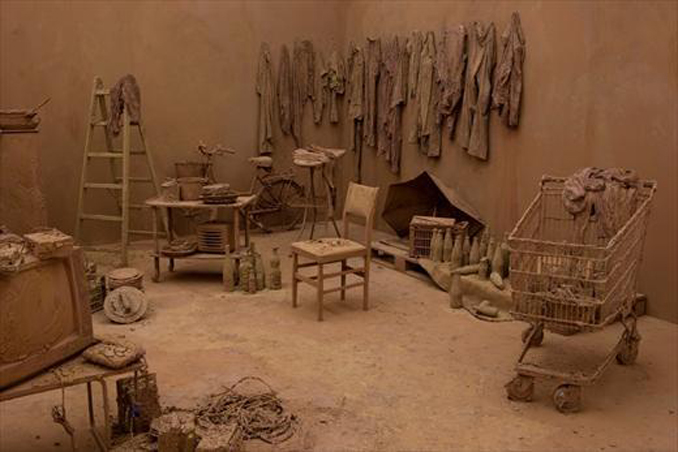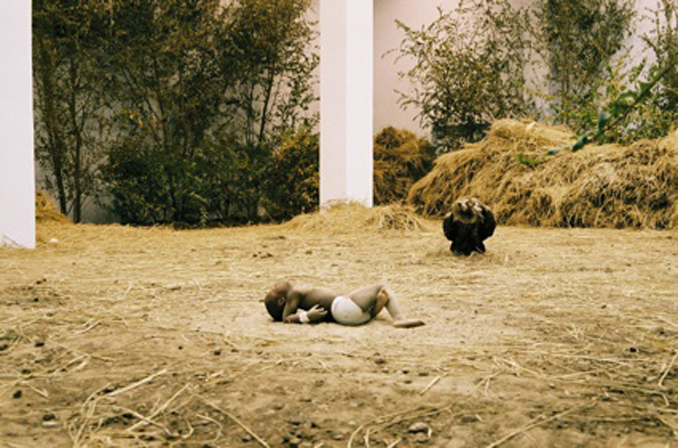Written by: Alia Bilgrami - Posted on: April 14, 2013 |  Comments | 中国 (Chinese)
Comments | 中国 (Chinese)
Google Translation: اُردو | 中文
London is always buzzing with exciting contemporary art shows and I was looking forward to experiencing some first hand on my trip this fall. Hayward has always been one of my favourites and I was fortunate to catch the new exhibit on China just in time. To be honest, I am not familiar with contemporary Chinese art per se. While studying at Central Saint Martins, I had some interesting exchanges with some of my Chinese peers, but the work at Hayward was quite unexpected and left me with a completely new impression of what art from China is all about.
To me, at first glance, it was like any other contemporary art exhibit in Europe. There was no particular indication that the work was from China. The viewer was only made aware of the fact due to the title of the show and the publicity emphasizing that it was art from China. The work was mostly interactive; there were large sculptural installations, videos and performances, all created between 1993 and the present day. The nine artists showing at Hayward all dealt with ideas surrounding impermanence and through this, the possibility of growth, change and transformation.
On closer inspection, the work, curated by Stephanie Rosenthal, negotiated with restrictions and political conflict. The nature of the work, that rested firmly in a global contemporary context, was in keeping with certain key aspects of Eastern philosophy that embrace change and emphasize its importance.
China has gone through revolutionary changes that have understandably affected its art and culture as we clearly see in this exhibit. The emphasis on process was probably one of the most interesting aspects of this show. Chinese artists, reacting to their environment, created work that was transient – they were not afraid of having to start again from scratch. It seems to me as though this gave them an incredible sense of empowerment that many artists lack today, myself included. Art wasn’t about creating a pretty picture or having a final ‘product’ to show at the end of the day. It was about the act of making art, the discoveries along the way and experimenting with new media.
In the mid 1990’s, Chinese artists began to create work that was edgy, experimental and consequentially moved many steps away from traditional Chinese art. Whether this is good or bad is not my place to say but it certainly speaks volumes about the dynamism of today’s China.
On closer inspection, one gained insight into the many opposites that comprise modern China. The viewer’s perception was questioned in many ways and one was forced to interact with the art, to become part of the process and to leave behind any preconceived notions. Our expectations were definitely provoked.
 |
| CHEN ZHEN - Purification Room (2000, 2012) Photo: Linda Nylind |
Chen Zhen’s work was most fascinating as you stood there wondering how an entire room could be masked in clay. In works like Purification Room (2000/2012) the objects in the installation had been purified with natural materials after they had been used; ‘for sublimating a latent spirit; and for provoking a new destiny at the fatal end of these objects.’ Zhen grew up during the Cultural Revolution and experienced the period of ‘reform and opening up’ in China firsthand. He was diagnosed with a blood disease when he was just 25 and was told he only had five years to live. He then went on to live till the age of 45, but in light of his own journey, the work he produced was a comment on the human condition. To him, the organic materials he used, like water, earth and ash, were ‘images of the essence, of birth, of the source from which objects come, but also the place they return to after having circulated in society.’ The works on display in this exhibit were definitely contemporary; however, Zhen’s work incorporated both traditional eastern thinking with reference to the phases of life in Buddhism, as well as western philosophies, which might be a result of his move to Paris.
The only other artist in this exhibition who made references to eastern philosophy, particularly Taoism, was Liang Shaoji. His work was inspired by nature, the circle of life, which he exemplified with silk worms. His work with silkworms focused on the need to grow and adapt to changing circumstances as a means to survive this technologized, materialistic world. Perhaps it is for this reason that he has adopted the rural countryside of South China as his home where he can indulge in meditation.
Globalisation and the impact of a new consumerist society was at the centre of Xu Zhen’s work, the youngest artist showing at Hayward, who grew up when rapid commercial development was taking place in China and the economy was starting to boom. In In Just a Blink of an Eye (2005/2012) the viewer was met with an illusion of a person suspended in mid-fall. Perhaps this was a reminder of our shortcomings or failings and the fact that with every rise there is a fall. The most remarkable aspect about his work was that through his art he forced the viewer into the shoes of a photojournalist; he asked grave questions regarding voyeurism and human exploitation through war, politics or both.
 |
| Xu Zhen - The Starving of Sudan, 2008 |
This was most evident in the work titled The Starving of Sudan (2008). The artist stated, ‘it’s about questioning the nature of ethics; people have to decide where they stand.’ Recreating Kevin Carter’s 1993 Pulitzer Prize winning photograph of a vulture waiting besides a starving child in the desert, the video posed serious questions about what is right and wrong. Xu’s point here was that people often do what they condemn and this hypocrisy was proved by him in a social experiment that he contrived by observing the reactions of viewers and the press when they first encountered the performance in Beijing’s Long March Space. They were at first shocked and appalled and then went on to take pictures and write about the work on their blogs. The child was from an immigrant Guinean family living in Guangzhou and was supervised by her mother who was paid by the artist. The vulture in his version was stuffed. He proved his point.
In 2009 Xu Zhen formed Madein Company, a creative corporation, and stopped practising as a solo artist in order to become its CEO. Work produced by the company that engages artists, technicians and co-ordinators to collaborate, was also on display. The aim of this company is quite similar to that of Xu Zhen’s (former) personal practice; to create faulty realities, to challenge ideas of reality, values, and belief.
The other artists in the show were Yingmei Duan, Sun Yuan & Peng Yu, Wang Jianwei and Gu Dexin. All the installations were gripping, some were interactive, some touched upon the issue of censorship while others simply evoked the need for change as the title of the show suggested, successfully creating a platform for thinking.
The author wishes to acknowledge Samar Faisal Zia, tour guide at the Hayward Gallery.
Click to view picture gallery